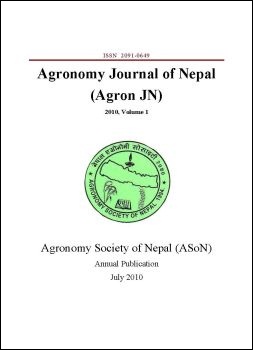Inclusion of grain legumes in rice based systems in the mid-hills of central Nepal
DOI:
https://doi.org/10.3126/ajn.v1i0.7543Keywords:
Participatory variety selection, farmers, farming systemsAbstract
Grain legumes are the important crops for improving soil condition and dietary status of humans. These crops could improve both soil and human health if grown in the prevailing farming systems. Keeping these view in mind, participatory varietals selection (PVS) on lentil (Lens esculents L.), mung bean (Vigna radiata ) and cowpea (Vigna ungiculuta) was conducted in the central mid hills (Ramechha and Sindhuli districts) of Nepal. Five varieties of lentil (ILL 7982, ILL 6829, ILL 7537, ILL 7723 and Simal), four of mung bean (VC 3960, Kalyan, Pratiksha and Farmers' Local) and cowpea (Surya, Prakash, IT 86-2089-5F and America) were tested at different locations of those districts under rice-wheat-fallow and rice-fallow-maize systems during 2007 to 2009. All of those varieties were tested in farmers’ field condition keeping farmers as a replication in RCB design with ten replications for each crop. Agronomic practices were performed by farmers as and when necessary. Among the tested varieties of lentil, ILL 7982 produced the highest grain yield of 1347 kg/ha whereas Sital produced the lowest grain yield of 1003kg/ha. Similarly for mung bean, the variety VC 3960 gave the highest grain yield of 1145kg/ha and Pratiksha produced the lowest grain yield of 975 kg/ha. Likewise, among the tested varieties of cowpea, America gave the highest pod yield of 5320 kg/ha and Prakash gave the lowest pod yield of 3400 kg/ha. These varieties were identified suitable for further promotion in different cropping patterns such as rice-lentil- maize, rice-maize/mung bean, ricemaize/ cowpea systems. Simple economic analysis of the cropping systems under question indicated that inclusion of legumes in the systems seemed highly lucrative compared to maize and wheat. Therefore, it is anticipated that integration of legumes in the systems could enrich soil as well as it would be beneficial to farmers because of nutritional status attractive price in the market of these crops.
DOI: http://dx.doi.org/10.3126/ajn.v1i0.7543
Agronomy Journal of Nepal (Agron JN) Vol. 1: 2010 pp.61-66
Downloads
Downloads
Published
How to Cite
Issue
Section
License
ASON permits for free use, distribution and reproduction in any medium if the original work is properly cited and not used for commercial purposes.




